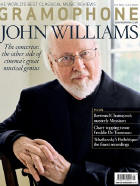Texte paru dans: / Appeared in: |
|
|
Outil de traduction |
|
|
It’s always a boon when it’s clear from the off that there’s a real relationship at the heart of a recording, and such is the case for the fascinating ‘The Mandolin Seasons’, recorded over three days in the Grosser Saal of the Leipzig Gewandhaus. However, I’m not talking about the obvious one between Vivaldi’s Four Seasons and Piazzolla’s 1965 homage, Las Cuatro Estaciones Porteñas, but the one between its mandolin soloist Jacob Reuven and its accordionist soloist and harpsichordist Omer Meir Wellber. This pair have been musical collaborators since childhood, both of them hailing from the Israeli desert city of Be’er Sheva. The mandolin and accordion are the national instruments they learnt as schoolboys; and needless perhaps to say, the equal boon here is to hear Wellber wearing such a different musical hat to that of his usual symphonic conducting activities. I don’t use the word ‘fascinating’ lazily. Vivaldi’s own mandolin concertos aren’t his most interesting works. By contrast, though, Reuven’s mandolin take on The Four Seasons’ famously virtuoso violin solos presents a panoply of colours, thanks to a holy trinity of a modern instrument, his own mandolin technique, based on Europe’s various violin schools, and shedloads of imagination. Listen to the shaping, shading and variety of his embellishments in the solos in the first movement of Vivaldi’s Spring. And these qualities then equally feed his Piazzolla arrangements (each movement of which follows its corresponding Vivaldi one); the double-stopped glissandos with which he opens Piazzolla’s Summer are properly exciting, for instance. Then there’s Wellber’s accordion: never would I have dreamt that a solo accordion could bestow such a perfect darkness on the opening of the central Largo of Vivaldi’s Winter, or that the combination of Reuven’s hushed, shimmering mandolin textures and Wellber’s steadier accordion tone would combine to such riveting effect in the first movement of Autumn. In fact, beyond Wellber’s equally virtuoso accordion technique (the nuance of his trills in Vivaldi’s Summer first movement), it’s his timbre and texture I find especially enjoyable. Take the addition of accordion to the ensemble texture in that same Vivaldi Summer movement, because it tints the sound quality to produce something that – bizarrely and brilliantly – sounds almost electric. Wellber’s harpsichord improvisation is also fabulously creative, one great moment being his delicately dissonant raining scales at the end of Piazzolla’s Summer. It’s not just Reuven and Wellber, either. There’s also the subtle Latin rubato and directness of communication from cellist Moritz Klauk in his Piazzolla Autumn solo, the 18 Gewandhaus string players hanging off his every note as they accompany; and indeed, their own superglued playing brilliantly brings off other moments such as the concluding Presto of Vivaldi’s Summer. Even the Grosser Saal gets to meaningfully contribute: the Vivaldian Spring ghosts from harpsichord and strings at the close of Piazzolla’s Spring are show-stopping not just for the tension-flecked antiquity of the playing but for the way it suddenly sounds lost and echoing in the space. In a steadily expanding catalogue of Vivaldi and Piazzolla Four Seasons offerings, this has brought something genuinely unique and worthwhile to the table. |
|




